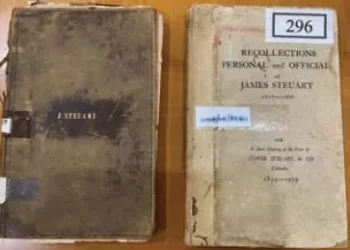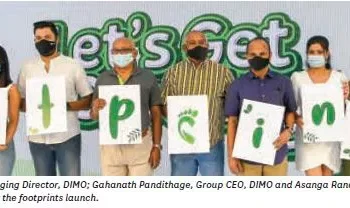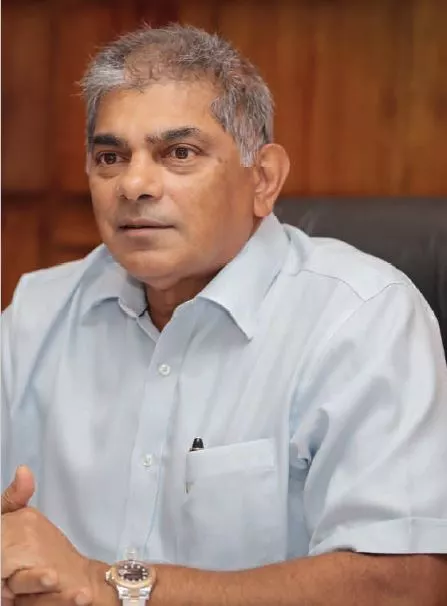
Rohan Fernando, Chairman, SLTMobitel.
Rohan Fernando, Chairman, SLTMobitel, expressed satisfaction in the journey of recovery that the new Board had embarked upon assuming office to increase profitability and to regain the place due to SLTMobitel in the corporate world, as well as in the communications industry and expanding its portfolio beyond Sri Lanka, by launching SLT Global. Under his stewardship SLTMobitel was introduced as a unified corporate brand identity that hopes to leverage on the new binary codes representation signaling a direction in offering complete digital solutions to the country.
By Udeshi Amarasinghe. Assisted by Jennifer Paldano Goonewardene.
Photography Menaka Aravinda.
What has been SLT’s performance over the last year?
I am extremely happy with SLT’s performance, which the whole country is aware of, and along with success came the brickbats, which always come to the tree that bears fruit. When the new board took over the company in January 2020, it took us a few months to understand the operations of the company. Upon examination we found that although there had been good management systems, some of them had been bypassed for various reasons. As a result, there were questions about accountability, responsibility, and vulnerability to external forces. External forces in this instance were political forces, suppliers, vendors as well as competitors and the concerns of shareholders, specifically the company’s foreign shareholders who had their misgivings on the way the business was conducted in the past.
The first few months in office were spent identifying and fixing the leakages. By doing so, we were able to save a lot of money, in the first instance, on operation costs. I believe that we will end the year with a substantial saving on operation costs, which would be close to a billion rupees. As of now, accounts are being audited and will be presented to the board. We are hoping to make significant savings on operational costs, interest cost and reduce our long-term debt burden. Our long-term debt burden at the end of December 2019 was 53 billion rupees. We hope to and also are confident of reducing the debt burden by at least ten billion rupees as at December 2020. The substantial interest benefits expected and the substantial depreciation in the P&L will help with future cash flows.
Our progress in the past year has been helped by primarily winning the confidence of the staff, especially the trade unions. SLT has been infamous for strikes and trade union action. People have gone to the extent of climbing communication towers as trade union action. One such person who had climbed a communication tower called to express his joy after the corrective actions we took in the first few months. We were able to win employees’ confidence by demonstrating that we are here not for a job, but to fulfil a national task. Winning employees’ confidence is very important for a company to turnaround. I speak of a turnaround because SLT has been ranked number one in telecommunications until 2012. SLT has been in operation for over 160 years, only to be overtaken by a newcomer, of course with due credit to this new entity, who has reached the number one slot. Naturally, we have to strive harder to regain our rightful position in the country’s telecommunication industry as the number one telecommunication service provider in all aspects of service and product delivery, asset base, profitability, customer satisfaction and industrial harmony among employees. We are very happy with the journey of recovery that we had started upon assuming office to increase profitability and to regain the place due to us in the corporate world, as well as in the communications industry. We want to be a global player now. As we look beyond Sri Lanka we have established SLT Global.
What was the rationale behind the transformation in the brand identity?
Mobitel is a fully owned subsidiary company of SLT. Other subsidiary companies include Peo TV, SLT Digital Services and SLT Services, which engage in systems integration and outside plant operations. The SLT Campus and the SLT Muve taxi app, I feel, do not come under our core business, as we are neither a taxi company nor a higher education university, and these are specialties that can be done only by specialists in the subject. We are trying to divest these two entities. SLT training centers will be another subsidiary section that we hope to empower. These training centers will be enhanced to teach students and SLT employees IT and technical aspects of telecommunication.
On the merging of the two brands SLT & MOBITEL, we optimized the synergy between the two brands, in the telecommunication field, which were being run separately. In fact, they were in an unhealthy competition operating as separate entities. Thus, the board decided in May 2020 to converge the two brands onto a single platform and to project them as a single brand entity to the customer. We now operate as a unified brand and have consolidated our sales and marketing tasks under a joint working group representing the different companies in the SLT Group. It was not so earlier. A good example is the disjointed sales and marketing of group companies spending around four billion rupees annually on promotional activities, but we couldn’t see significant growth in the top line of the customer base. The unified brand option was established as a result of the pitch by advertising companies and the change did not cost additional money, contrary to the false claims in political circles and social media. We have also instituted strict financial discipline in cost recognition especially the interest costs to reflect the correlation between the P&L and cash flow.
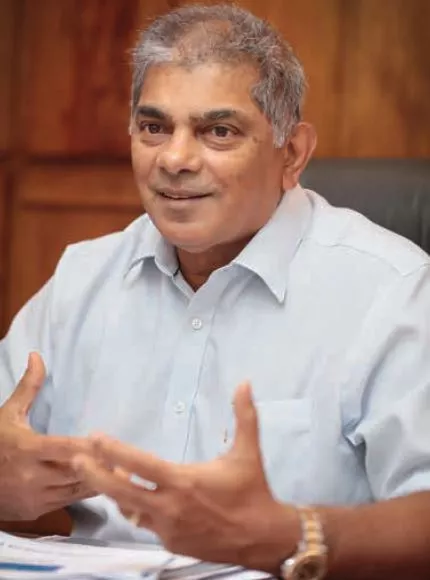
All companies in the group were realigned for centralized operation reporting to a Group CEO, Group CFO, Chief People’s Officer and Group Treasury Management. We see a lot of improvement in them working together. They are from different cultures. Mobitel is primarily a corporate culture; SLT has primarily a department culture. This is how these two entities have functioned in the past and will continue to do so in the future as well. You can’t marry the two overnight. I earnestly pray that a corporate culture would sink into SLT and one day become a single culture. This of course will take time. Until such time, the companies will operate separately, but marketing will be strategized from a unified platform. We can go anywhere in the country and the world with this modern brand identity.
There is a misnomer that SLT has been diluted. SLT is still the main company. People tend to mix up the fact that the company and the brand are not the same. What matters when you go to the market is the brand. The company is only a registered entity. Similarly, SLT is the new corporate identity and will be the entity that will operate, manage and run the goods and services as well as the brand expansion. I bring my personal business experience onto the table and as chairperson I don’t enforce upon the management team. I am only a non-executive chairman and an independent director and hence, I don’t try to use any executive powers, which will be detrimental to the company and is not in sync with corporate governance. Therefore, what I bring are ideas and suggestions for the team to discuss, debate and disseminate to come up with workable solutions.
Today, I can proudly say that we have tremendous harmony as merged entities. Initially, even the trade unions were very worried, but, today, they are very happy to embrace the change.One must keep in mind that everything has a lifespan; nothing is permanent. Even a brand if it doesn’t evolve with the changes taking place in the market and evolve according to the dictates of the consumer and the needs of society, it will either be stagnant or even die. A good example is Kodak, which refused to believe the changes that were taking place in the world of electronics. We have to learn from global scenarios. There have been so many brands that have failed as a result, such as Xerox. We didn’t use the term photocopy then, it used to be either Xerox copy or Xeroxing, but, things today have changed, we can scan a document rather than make a photocopy and have a digital copy over a paper copy.
SLT is primarily the telephone, but if we were to embrace only the telephone disregarding other developments, we would have closed the shop a long time ago. The world is running on digitalization. Hence, we have to move on to the digital platform. We will be a thing of the past if we fail to understand this reality as the primary telecommunication service provider. SLT has been through many changes, changing from a department to a process of restructuring and subsequently more changes such as the acquisition of Mobitel in 2002 and new changes in 2015 and after. The earlier tagline ‘One country. One voice’ led to too many questions being asked.
Moving forward the brand insignia will be in the spotlight, thereby in time, people will identify the product by its brand logo. The changes will apply to our 5G, 4G, fiber optic and Peo TV services as well. The new logo with the binary codes representation is simple but has reasoning behind it; it has a purpose of achieving brand expansion and recognition by the consumer without limiting it to language. For instance, the Nike insignia has no language, but it has an identity, similarly in the future, SLT’s new insignia will accompany all its brands. The new insignia will be the point of connection for all the other products. This is the transformation that we are currently engaged in and already there is a great deal of affinity for the brand. In introducing this change, I had the least amount of objections, but a lot of questions were asked, and so, a great deal of time was spent explaining the rationale behind the new move.
What else have you planned to change and develop at SLT?
We began 2021 launching the new brand identity and we are in the process of restructuring the subsidiaries to be profit centers and not to be a burden to the main company. These subsidiaries will have their own CEOs to run operations and bring in profits. We are empowering our training centers, three in Welisara, Moratuwa and Peradeniya, the two in Anuradhapura and Galle are dormant. We intend to shift these two dormant training centers, from Anuradhapura to Batticaloa and from Galle to Matara, so that we cover the entire island. There are many people in Batticaloa from conflict affected areas who could be empowered through this move. The people here have encountered a lot of problems even after the war. There are 30,000 war widows in the Batticaloa district and 8,000 war-affected disabled persons who are challenged by daily struggles. We believe that our extensive network of communication and offices can empower some of these people, which is our national duty. We are not only doing a business, but also a national service.
We have identified the presence of a number of micro-level businesses in the east. These are hardworking people who lack the platform to transform their micro enterprise into a small business. They will enter the SME sector if they transform their micro business into a small business, a process that we can help in through our extensive network and connectivity. The best cashew comes from Batticaloa, Ampara and Kalmunai; they also make good curd from buffalo milk, they are known for making good treacle and handicrafts and fish products. Unfortunately their products are bought at bargain prices by intermediaries who make a lot of money. In response, SLT has set up the Hela Wiru platform, to promote the concept of plant to plate. We are in the process of testing this platform and hope to make the multilingual platform available to the entire country where entrepreneurs will be able to log onto the platform, enter their products online and the platform will find the buyer and the logistics. This platform offers a complete service of enabling product promotion, buyers and logistics and financial services. For instance, Bank of Ceylon and People’s Bank are on board. The Hela Wiru platform provides connectivity and the facilities for micro-level farmers and businesspeople to get the right value for their products by eliminating intermediaries.
Once the five training centers become fully operational, we want them to be places that churn out technically qualified people for the Telco industry, here and abroad. I have been told that there is a huge demand for people with technical qualifications, who are in short supply, so we intend to fill that void. It will be a core business as well. Through this venture, we will be creating an avenue for people who retire at the age of 60, but have a great deal of value left in them, to be able to join our revamped training centers. We hope to draft engineers and technicians over 60 into a knowledge pool that we have created, through which they will be able to work as lecturers in these training centers. This will allow them to earn a decent stipend after retirement by imparting their knowledge. It will be a part time job that will keep them engaged and not let them drift after retirement.
We intend to divest non-core businesses, SLT Campus and the taxi service. We have deployed an investment banker to find a suitable partner or buyer for this purpose.
Another important area that we hope to focus on is research and development, which has been lacking at SLT. We have not had focused research up to now. The SLT section at Trace City is where the blueprint for the new R&D department has been established and hopefully by February we will be able to launch a demand driven focus research and development center for SLTMobitel. We have already identified 72 projects from which we will select the pertinent areas for research to move to pilot projects and subsequent commercialization. Some of the research will focus on applications, coding and processes, such as cost cutting processes and processes to improve efficiency.
Service is primary in our business and customers are the most important to us. They demand quick solutions in the event of a breakdown. Hence, we have initiated a quality assurance protocol. People will be trained at the five SLT institutions to be quality conscious, like the manner in which an employee presents himself to a customer, such as when entering a house, to be presentable through cleanliness and good health practices, especially in the current pandemic environment. And when they leave a house they should not leave behind telltale marks of their presence and their work. We want to create two-member teams to deal with every aspect related with telecommunication and services in a house. Earlier there were different teams for fixed wire telephone connections, Peo TV connections, and smart home options and for wiring. This will be a thing of the past.
We intend to make every home a smart home in Sri Lanka, a concept we are driven to achieve. Right now, Sri Lanka has 30 million mobile phones in a 22 million population. We have three million households, so every home has a telephone connection and a television. The basic format for a smart home concept is to make that house a home with entertainment, connection and security. Our strategy is to find out the number of people in a household and the users of telephone, then offer a bundle package of Wi-Fi and data to the house. The TV in a household may not be a smart one; so our R&D is developing a unique application that can be plugged in with a chip to make it a smart TV, so that households can run a small business or a communication agency or make zoom calls. At a higher level, security cameras will allow users to have remote connectivity to switches. At an advanced level of smart home, an individual will be able to use the smartphone to remotely see what’s happening at home from the cameras and switch on the air-conditioning and the lights prior to reaching home, so the ambient temperature is set when the individual reaches home. There are unlimited options through digitalization to promote the smart home concept.
What is SLT doing regarding the industrial waste and other challenges that are prevalent in the company?
We are also working on a concept called waste to cash. SLT has a lot of waste, more like industrial residue such as copper wires, cabinets, and electronic waste and damaged telegraphic posts and rails. Right now we have a project to convert the massive amount of damaged telegraphic posts to fence posts, primarily for areas that face elephant invasions into homesteads and plantations, we intend to convert this huge amount of waste into cash and we hope to rake in a substantial amount to the cash flow from this year.
One area that we have failed to be diligent in is the maintenance of stocks and debtors. We are currently conducting an age analysis to determine the age of some of the stocks that have been lying in our warehouses and have engaged our debtors to recover long outstanding dues. The procurement process has worried us a great deal, because we had a lot of issues with many of the agents involved in the procurement process, such as agents going missing and having to face legal challenges and escalation of costs. Hence, we have taken a policy decision to work only with principals. We are a big company capable of working directly with the top principals of the world for procurement. We are also in the process of trying to introduce new systems for underground cabling, such as micro trenching. The President has made us aware of the visible distorted hanging wires and distorted poles on the road, a sight that doesn’t look good for a city. We have taken that to heart and initiated a project, starting with one zone, to remove telegraphic posts. We will be working with the Water Board, the Electricity Board, the UDA, the RDA and the local authorities to determine the best way to have duct pathways along the roads instead of doing so on poles. This way, we can create a beautiful city. Although the cost of investment will be high in this instance, the eventual payoff will be when there’s a reduction in the service costs. These are some of the projects earmarked for implementation in 2021, which will save a lot of money for us and will make SLT a modern company. As a result we will be releasing less waste to the environment.
Another initiative will be to go into is solar power; we are already working with Tesla for power walls to migrate from diesel generated power to sustainable solar power wherever possible. Such initiatives will help save money and reduce environmental pollution. These are ambitious programs that we hope to at least initiate in 2021. I envisage a lot of benefits from these proposed initiatives.
Considering the current situation SLTMobitel has been able to perform well. What was the thinking?
When the chips are down, you need to look where the new opportunities are. Complaining will not help find new opportunities. The saying is that one must aim for the moon, and you will at least be among the stars. We have to think big and aim high, then you will find the niche markets. At SLT, we are aware that the world is moving rapidly towards a digital landscape; everything in the world will have some form of digital connectivity and the country too should develop to such a landscape if we are to be successful. We hope to offer different digital platforms to the country; we hope to have one for judicial tasks; the Hela Wiru is a digital platform for the agriculture sector; in education we plan to connect nearly 2,000 schools through fiber optic lines to provide uninterrupted connectivity; with the railways we are offering a platform for e-ticketing, and to CTB the booking for medical tests required for a driver’s license through e-channeling. The CTB has also been given the WiFi connectivity for the park and ride city bus service, which will help people to do their work while traveling. We see a great deal of potential.
A majority want to look at only the negative side of a situation. On the positive side, we are a country that has emerged from a war; the war was a very difficult period for all of us with security concerns for our safety when bombs were exploding in public transport and government buildings. Then the chaos was in Sri Lanka, but today, the entire world is in turmoil, comparatively Sri Lanka’s situation is not so bad, especially when we consider the death rate from the pandemic. There’s so much attention from the media on daily figures, but Sri Lanka has been through worse epidemics in the past; we had outbreaks of malaria; leprosy was quite a serious disease that led to an isolation zone being set up off Mannar on an island and a special hospital in the suburbs.
In recent years, we have had an outbreak of dengue and Japanese Encephalitis and every year Sri Lankans experience a flu season. COVID-19 is also a type of viral flu. We have been inoculated against TB, which is also a virus that can affect the breathing system. Therefore, I don’t see much of a difference between the disease outbreaks that we have experienced in the past and COVID-19, which is not a fatal disease although it affects lungs; yes, it can be fatal owing to negligence or underlying illnesses. The high numbers we see around the globe are in regions that anyway experience issues during an outbreak of the flu, for which they have flu shots, which they take before the onset of the flu season and the COVID-19 vaccine is also another flu shot. Why should we panic and demand that the country be shut down? For whose benefit is it if the economy collapses as a result? Is it in the best interest of the country or for political expediency? These events worry me as we destroy our country’s future by revolving around petty issues. Is COVID-19 the biggest issue we have? People are moving about and are at work; a demand for our tea has been created; for the first time our balance of payment has narrowed down to a manageable level. Our foreign reserves have gone up to 5.6 billion dollars; a figure we couldn’t have achieved had we failed.
The Port City project has been reactivated and SLT has offered the smart city option to the Port City; the Hambantota Industrial Zone has also been activated with the construction of the largest tire manufacturing plant in South Asia. We were importing a large number of food items from salt to fish, green gram to cowpea, when we could grow all that locally and also export. Why aren’t people talking about these positives rather than dwelling on the daily death rate due to COVID-19? Positive people are taking things under their control and looking at the opportunities. I’m not interested in what people speak in parliament, some have spoken ill of SLT as well, especially about the two billion rupees spent on brand unification, whereas in truth we have not spent a cent on brand unification. What we did was to invite advertising companies to pitch in order to select a single entity to do our promotions and one of the main tasks was to give us a unified brand identity, which we could consider. The company that did best was Phoenix Advertising, which we have selected; it came as a bonus for us and not as a cost. We have engaged them for the annual marketing plan and this was their entry to win the contract. People have to be smart in meeting challenges and if one is smart, Sri Lanka has ample opportunities.
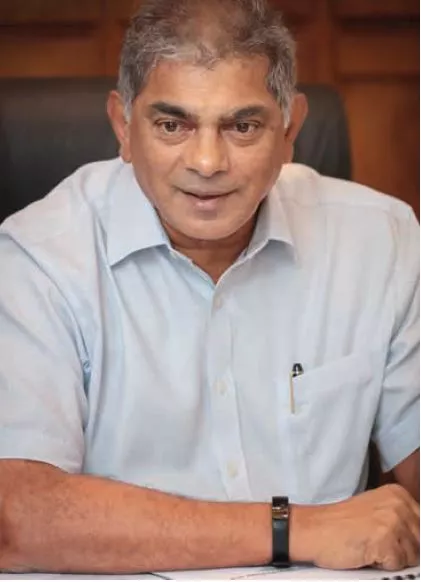
Future prospects?
I am very hopeful that the country has potential despite the rabble-rousers and prophets of doom trying to create a very dark picture. I have traveled inside the country. During the lockdown I traveled to the north and the east and the south to inspect the operations, which made me realize that digital transformation will unite the country and with connectivity even the most rural village could be empowered. This would allow the dissemination of information, technology and true news. Unfortunately, we have allowed the freedom of expression to reach unprecedented levels, which has given freedom to individuals to malign anyone on digital platforms from anywhere in the world without being challenged or questioned.
I feel the Government needs to introduce some control to manage such scenarios. What do we see in the USA, the so called temple of democracy? They are suppressing all anti-Biden news and propaganda. Donald Trump’s twitter account has been blocked permanently and they are also identifying his supporters to target them and block their freedom of expression on social media. How can they do it and in turn question our actions? This shows that freedom of expression is a good thing when used positively. I hope this Government will take note of what’s taking place globally and take action in Sri Lanka to protect the rights of people who are targeted, protect their privacy and dignity from unsubstantiated online rhetoric.
The country must also have stable policies, which was not the case in the past few years; the leaders wavered. Stable policies are important for investment. The state minister for finance had said that Sri Lanka has five trillion rupees in bank deposits, which if invested in development and to strengthen the capital market, the country will emerge stronger. The interest regime has to be managed, which is key to development. People will not invest if interest rates are very high, they’d rather invest the money in a bank to reap the benefits of high interest. We must learn from the most successful economies of the world that have low finance costs.



